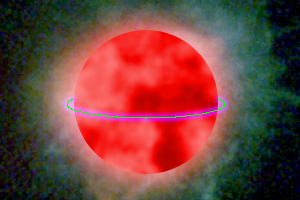Hypergiants are quite rare—owing not so much to the enormous amounts of material they comprise, but to their short lifespan. The bigger the star, the greater their core pressure and the faster they consume their fuel through nuclear fusion.
While our Sun, five billion years into its life with at least another five or so billion to go, fuses its hydrogen into helium at a modest rate (about 600 million tons per second—compare this to the combined weight of all humans on Earth: 6 billion people at roughly 100 pounds a piece gives…huh, about 600 million tons…), a hypergiant blasts through its fuel in a short few million years, synthesizing through fusion a great deal of heavier elements (helium, silicon, oxygen, calcium, carbon and more) as it goes.
So, most of the hypergiants that ever existed have long since run out of fuel, collapsed, and gone "hypernova"—the hypergiant's ten-upmanship on the puny stellar death-puff known as a supernova….
But back to Raghavendra's question: are there Orange Hypergiants? Unfortunately, I couldn't just send him a quick yes or no. First of all, rare as they are, there aren't many of these objects known to exist in our galaxy—so finding any specific example of a hypergiant was a bit like trying to find a Super Lotto jackpot winner named Daisy. Sure, one MIGHT exist, but does one, really?
Star colors in general depend on the temperature of the star; the hotter the bluer, the cooler the redder. The astronomers' famous labeling scheme for color, or spectral class, is OBAFGKM ("Oh, be a fine [girl or guy; pick one], kiss me"). Orange stars fall into the K slot; not quite as cool and red as an M, but right next door.
So the question boiled down to, are there any K-class hypergiants? Are there? Daisy? Daisy? I didn't find any in the lists I looked over…and, furthermore, I learned that hypergiants, as some classify them today, fall into lump categories of blue, yellow, and red. One definition lumped K-types into the yellow category, so even if you found a K-type hypergiant, you might be forced to call it yellow….
It's all how we classify these things, of course. At one time, before we knew of the existence of numerous objects like Pluto, Pluto was classified as a planet—although the smallest. Once we found other objects of Pluto's stature out there, we created the category Dwarf Planet and threw Pluto in with the lot.
So maybe, if we find more and more examples of hypergiants, including that elusive K-class beast, we will open up the category of Orange Hypergiant, so yes, Raghavendra, there might be some yet….
37.8148 -122.178
 Diagram comparing the diameter of VY Canis Majoris and
Diagram comparing the diameter of VY Canis Majoris and